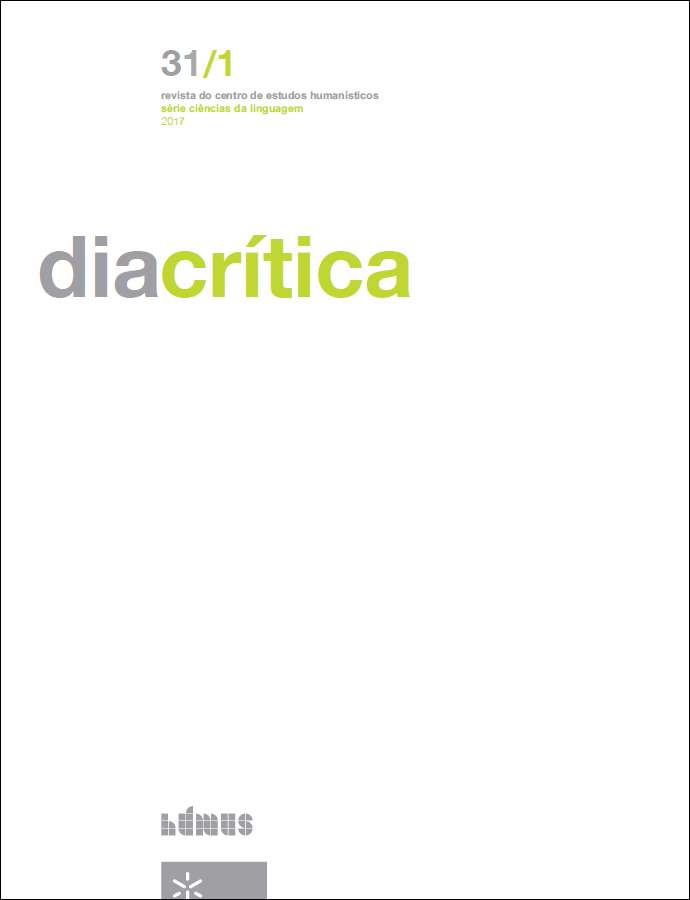Para além das ondas. Um ponto de partida sobre o significado social da variação entre ditongo nasal átono final e vogal oral no Português Brasileiro
DOI:
https://doi.org/10.21814/diacritica.4918Palavras-chave:
variação, avaliação, estilo de falaResumo
Este artigo apresenta o resultado de estudo sobre o significado social da variação entre ditongo nasal átono final e vogal oral, como em homem ~ homi, a partir do comportamento observado de falantes do Português Brasileiro em função da variável estilo de fala. Além disso, apresenta uma reflexão sobre as diferentes “ondas” ou abordagens do estudo do significado social da variação conforme apresentadas por Eckert (2012) para situar o ponto de partida deste estudo no conjunto de práticas analíticas para o estudo da variação desenvolvidas no âmbito da abordagem da Sociolinguística. Argumenta-se que o estudo do significado social da variação constitui um desafio interdisciplinar que deve abarcar tanto aspectos macro quanto microssociais. Especificamente em relação ao objeto de estudo, os resultados para estilo de fala indicaram que a variação apresenta estratificação estilística, característica típica de marcador linguístico.
Referências
Battisti, E. (2002). A redução dos ditongos nasais átonos. In: Bisol, L.; Brescancini, C. (Orgs.) Fonologia e variação - recortes do português brasileiro. Porto Alegre: EDIPUCRS, 183-202.
Bell, A. (1984). Language style as audience design. Language in Society, 13(2), 145-201.
Bortoni, S. M., Gomes, C. A., Malvar, E. (2003). The Principle of Saliency Revisited. In: Schlieben-Lange, B.; Koch, I. V., Jungbluth, K. (Orgs.) Dialog Zwischen den Schulen: Soziolinguistische, konversationanalytische und generative Beiträge aus Brasilien. Münster: Nodus Publikationen, 61-72.
Bybee, J. (2001). Phonology and language use. Cambridge: Cambridge University Press.
Bybee, J. (2015). Language Change. Cambridge: Cambridge University Press.
Chambers, J. K. (2002). Patterns of variation including change. In: Chambers. J. K., Trudgill, P., Schilling-Estes, N. (orgs.) The Handbook of Language Variation and Change. Oxford: Blackwell, 349-372.
Coetzee, A., Kawahara, S. (2013). Frequency biases in phonological variation. Natural Language and Linguistic Theory 40(1), 47-89.
Eckert, P. (1989). Jocks and Burnouts: Social Categories and Identity in the High School. New York: Teach. Coll. Press.
Eckert, P. (2000). Linguistic Variation as Social Practice. Oxford: Blackwell, 2000.
Eckert, P. (2012). Three waves of variation study: the emergence of meaning in the study of sociolinguistic variation. Annual Review of Anthropology, Palo Alto, 41, 87-100.
Eckert, P. (2015). Variation, convention, and social meaning. Paper Presented at the Annual Meeting of the Linguistic Society of America. Oakland, CA. Jan. 7, 2005. Disponível em: < http://lingo.stanford.edu/sag/L204/EckertLSA2005.pdf >. Acesso em: 22 mar. 2016.
Gurvitch, G. (1982). As classes sociais. São Paulo: Global Editora.
Guy, G. R. (1981). Linguistic variation in Brazilian Portuguese: aspects of the phonology, syntax, and language history. PhD Dissertation, University of Pennsylvania.
Hora, D., Wetzels, L. (2011). A variação linguística e as restrições estilísticas. Revista da ABRALIN, n. esp., 147-188.
Labov, W. (1966). The Social Stratification of English in New York City. Washington, DC: Center for Applied Linguistics.
Labov, W. (1972a). The isolation of contextual styles. In Labov, W. Sociolinguistic Patterns. Philadelphia: University of Pennsilvania Press, 70-109.
Labov, W. (1972b). The reflexion of social processes in linguistic structure. In Labov, W. Sociolinguistic Patterns. Philadelphia: University of Pennsilvania Press, 110-121.
Lopes, L. W., Lima, I. L. B. (2015). Estilo e atitudes linguísticas quanto ao processo de palatalização das oclusivas dentais. Revista da ABRALIN, 14(1), 247-272.
Meyerhoff, M. (2008). Introducing Sociolinguistics. London: Routledge.
Milroy, L. (1987). Language and Social Networks. Oxford: Blackwell.
Milroy, L. (2002). Social Network. In: Chambers. J. K.;Trudgill, P.; Schilling-Estes, N. (Orgs.) The Handbook of Language Variation and Change. Oxford: Blackwell, 594-572.
Munson, B., Edwards, J., Beckman, M. (2005). Phonological knowledge in typical and atypical speech–sound development. Topics in Language Disorders 25(3), 190-206.
Oushiro, L. (2015). Identidade na pluralidade: avaliação, produção e percepção lin guística na cidade de São Paulo. Tese de Doutorado. USP.
Pierrehumbert, J. B. (2003). Probabilistic Phonology: Discrimination and Robustness. In: Bod, R.; Hay, J.; Jannedy, S. (Orgs.) Probability Theory in Linguistics. The MIT Press: Cambridge MA, 177-228.
Pierrehumbert, J. B. (2016). Phonological representation: Beyond abstract versus episodic. Annual Review of Linguistics 2, 33-52.
Silverstein, M. (2003). Indexical order and the dialectics of sociolinguistic life. Language & Communication. 23, 193–229.
Schilling-Estes, N. (2002). Investigating Stylistic Variation. In: Chambers. J. K.,Trudgill, P., Schilling-Estes, N. (Orgs.) The Handbook of Language Variation and Change. Oxford: Blackwell, 375-401.
Schwindt, L. C., Silva, T. B. da (2010). Panorama da redução da nasalidade em ditongos átonos finais no português do sul do Brasil. In: Bisol, L., Collischon, G. (Orgs). Português do sul do Brasil: variação fonológica. Porto Alegre: EDIPUCRS, 15-30.
Schwindt, L. C., Silva, T. B. da, Quadros, E. S. de (2012). O papel da morfologia na redução da nasalidade em ditongos átonos finais no português do sul do Brasil. In: Lee, S-H. (Org.). Vogais além de Belo Horizonte. Belo Horizonte: Editora da UFMG, v. 1, 349-359.
Tarallo, F., Duarte, M. E. L. (1988). Processos de mudança linguística em progresso: a saliência vs não saliência de variantes. Ilha do Desterro, 20, 44-58.
Votre, S. (1978). Aspectos da variação fonológica na fala do Rio de Janeiro. Tese de Doutorado. Universidade Federal do Rio de Janeiro.
Weinheich, U, Labov.W, Herzog, M. (1968). Empirical Foundations for a Theory of Language Change. In: Lehmann, P., Malkiel, Y. (Orgs.) Directions for Historical Linguistics. Austin: University of Texas Press, 95-188.
Zhang, Q. (2005). A Chinese yuppie in Beijing: phonological variation and the construction of a new professional identity. Language in Society, 34, 431–66.
Downloads
Publicado
Como Citar
Edição
Secção
Licença
Direitos de Autor (c) 2023 Christina Abreu Gomes

Este trabalho encontra-se publicado com a Creative Commons Atribuição-NãoComercial 4.0.










